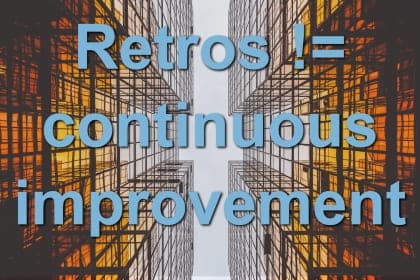- You are here:
- Home »
- Lean
Category Archives for Lean
Difference between Agile and Lean

What is the difference between Agile and Lean? A lot of people are asking about the difference between Agile and Lean. Are they the same? Which came first? Which is better? Better for what? That depends a lot on your context. You also need to understand the background and purpose of each approach. This article […]
Continue readingMisconceptions around Minimum Viable Product

One of the most controversial topics in Agile / Lean thinking at the moment is the Minimum Viable Product, or MVP. This article will try and clear up the misconceptions around Minimum Viable Product. What is a Minimum Viable Product? This concept came from Eric Ries’ influential book, The Lean Startup (which you should definitely read if […]
Continue readingCycle time and lead time

What are cycle time and lead time? Cycle time and Lead time are important concepts from Kanban and Lean Manufacturing. People often use them as metrics in Agile Software Development, however. And they can provide important insights into how your teams are operating. Cycle and Lead Time are measurements that describe how work is flowing into […]
Continue readingIt’s all about the flow

So it’s not really about the tools and processes. Right? Sure – it’s about people and interactions. Well, that sounds nice, but it’s not always helpful. What sort of people? What sort of interactions? There is something deep-running underneath all the talk and principles and concepts in Agile, Scrum, Lean, and all the rest. Sometimes […]
Continue readingProduction support in agile / scrum

A common question I see asked is “how do we do production support in agile / scrum?”. This is a harder problem than it might at first seem. It definitely adds some complexity to the problem of prioritizing work. There are three stages to solving it properly. What actually is production support? Production support or […]
Continue readingRetros are not continuous improvement

Retrospectives are one of the hallowed traditions of Agile software development. They are mentioned specifically as one of the twelve principles in the Agile Manifesto. They are one of only four regular activities prescribed in the Scrum guide. Extreme Programming says you must “fix XP when it breaks” (and talks a bit about retrospectives in that […]
Continue readingThe Lean wisdom at the heart of Agile

I had a discussion a little while ago with someone about what Agile is fundamentally about. The true, inner core of it. I gave some rambling and clumsy explanation. He gave a much better one: “Embracing change, and efficient collaboration”. This seemed fine at the time, but something started bugging me about it. It seemed […]
Continue readingGo see. Stop and fix it.

I’ve read a fair bit about Lean Manufacturing and Lean Software Development. Lean Manufacturing is old and Japanese and not really related to Agile at all. Lean Software Development is an attempt to apply some of those ideas to software development. It shares a lot in common with the values and principles of the Agile […]
Continue readingWays that cloud can support agile and lean startup

One of the biggest changes in information technology over the last ten years has been cloud computing. This change is huge and it is here to stay. While cloud is transforming businesses and governments around the world, it provides special advantages for certain types of organisations and work. This article will explain the ways in which […]
Continue readingWhy agile projects need to fund BML properly

One of the key concepts from Eric Ries’ seminal book, the Lean Startup, is “Build Measure Learn”, or BML. This means that rather than deliver projects in a sequence, organisations should build something small, measure behaviour and learn from those measurements, then loop back and build again (i.e. extend or change the product). While many […]
Continue reading